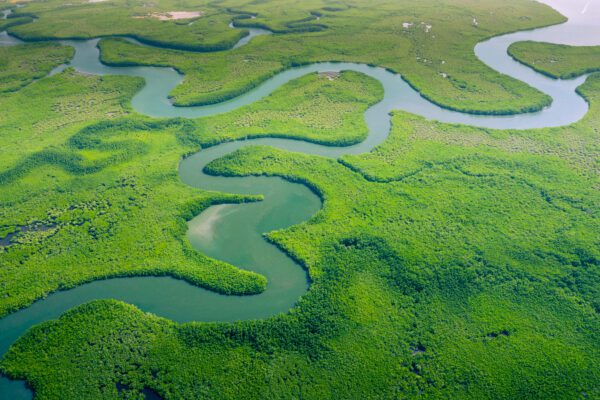
Where is our natural capital in the climate equation?
How Forests Protect Us: The Carbon, Climate, and Human Benefits of Nature
How Forests Protect Us: The Carbon, Climate, and Human Benefits of Nature
Forests are often called the “lungs of the Earth,” and for good reason. They absorb carbon dioxide, release oxygen, and provide the foundation for ecosystems that sustain life.
Yet their value extends far beyond their beauty or even their biodiversity. Forests are living infrastructure that shields societies from the worst impacts of climate change, from capturing billions of tonnes of carbon each year to cooling cities and providing livelihoods. Trees are among humanity’s most powerful allies in building a sustainable and resilient future.
Globally, forests absorb around 7.6 billion tonnes of CO₂ per year, offsetting roughly 20% of human-made emissions (Harris et al., 2021).
Tropical forests in the Amazon, Congo Basin, and Southeast Asia are particularly important carbon sinks, but boreal and temperate forests also store immense amounts of carbon in their soils and biomass. When forests are cleared or degraded, these carbon stores are released back into the atmosphere, contributing nearly 10–15% of annual global greenhouse gas emissions (Harris et al., 2021).
Reforestation and afforestation programs, such as the World Bank’s Forest Carbon Partnership Facility (FCPF) and initiatives under the UN’s REDD+ framework, have made measurable progress. For example, projects in countries like Brazil and Indonesia have restored millions of hectares of degraded land, capturing hundreds of millions of tonnes of CO₂ while improving water cycles and soil fertility. Depending on species and climate, restored forests typically sequester around 5–10 tCO₂ ha⁻¹ yr⁻¹ (Pan et al., 2011; Griscom et al., 2017; IPCC, 2019).
Can Industry and Forest Conservation Truly Coexist?
The paper and pulp industry, once linked to deforestation, is increasingly adopting sustainable practices. Many mills now use certified forestry (FSC, PEFC), recycling, and closed-loop production to reduce environmental impact.
They rely on renewable biomass energy, recycle water, and use residues like bark and sawdust for heat and power. By supporting sustainable timber and responsible forest management, the industry can promote reforestation and long-term carbon storage.
Why Does Forest Biodiversity Matter So Much?
The importance of natural capital, particularly in the form of forests, cannot be overstated, especially when considering its broader benefits. They are cited to harbour more than 80% of terrestrial biodiversity, although such a precise estimate is unlikely to be accurate given the changing state of knowledge of planetary biodiversity (FAO, 2020).
From insects that pollinate crops to apex predators that balance ecosystems. Biodiversity strengthens resilience: diverse forests recover faster from fire, drought, or disease. In turn, this ecological balance supports the human food chain and helps regulate the climate at both local and global levels.
The benefits of forests also extend to nourishing social well-being. Over 1.6 billion people depend on forest resources for food, medicine, and livelihoods (FAO, 2020). Urban residents benefit too: green spaces have been shown to reduce heat stress by up to 5°C (Forest Research, 2022), lower energy consumption, and improve mental health. In cities from Singapore to London, urban greening and tree-canopy programs form a critical part of climate adaptation plans, buffering floods, absorbing carbon, and offering psychological relief in the face of urban stress.
What Role Does Urban Green Infrastructure Play in Climate Adaptation?
The expansion of urban green infrastructure, including parks, green roofs, and street trees, plays a growing role in adapting to climate change. Vegetation captures stormwater, prevents erosion, filters pollutants, and improves air quality.
A study by the World Economic Forum (2022) estimated that investing US $583 billion in nature‑based solutions for urban infrastructure could generate over US $1.5 trillion in annual business value by 2030, from avoided flood damage to improved worker productivity.
Meanwhile, reforestation programs in both developing and developed economies, such as the Great Green Wall in Africa or China’s Grain for Green program, are creating new jobs, stabilising soils, and cooling regional climates. These projects demonstrate that restoring nature is not just an environmental imperative but an economic opportunity.
From Green Spaces to Green Strategies: How Businesses Can Lead on Sustainability
In essence, forests and green spaces serve as natural shields, absorbing carbon, mitigating climate extremes, filtering water, supporting biodiversity, and enhancing human life. They are both a line of defence and a source of renewal. As governments and industries move toward net-zero goals, integrating forest restoration, sustainable forestry, and urban greening into policy frameworks is not optional; it is fundamental.
Achieving genuine sustainability, however, requires more than ambition; it demands clear strategy, accurate data, and expert guidance.
At Inspired, we help organisations develop environmental goals and turn them into measurable action. From carbon measurement and carbon reduction planning to ESG reporting, nature-based solutions, and supply-chain resilience, our specialists provide the insight and tools needed to navigate the transition to a low-carbon future with confidence.
If you have any questions or would like to discuss how our experts could best support you, please contact our ESG consultants today.
Image Credit: Briksdalsbreen, Norway (Picture by Henry Kaye)










